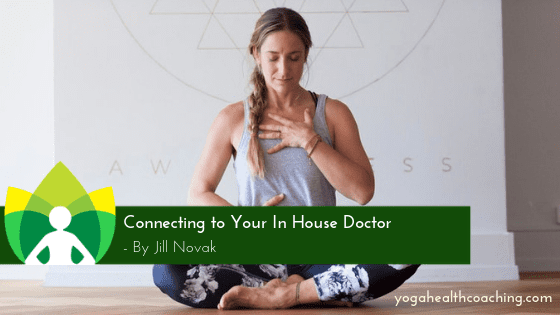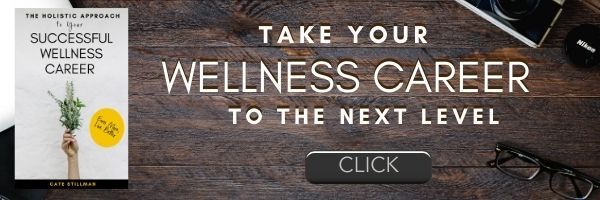
Connecting to Your In House Doctor
We have been taught to look outside of us for health answers.
We are supposed to go see a trained professional, get a test, a pill, a treatment from someone educated and up on the latest scientific studies and breakthroughs. They know how to help us. We take our aches and pains with the best descriptions we can muster and wait for their diagnosis.
The idea that we each have a lot of control over our health and can respond to these aches and pains with guidance from our own bodies can be dismissed swiftly and easily both by our own brains and by the health care systems around us.
Consider that the body has a greater ability to heal than anyone has ever allowed us to believe. As we practice yoga, ayurveda, and other embodying disciplines, we notice an experience that this body has a lot of wisdom that is is trying to share, and it just might have something to contribute when it comes to its own healing.
What if we could sync into inner wisdom and connect to an all knowing doctor who could help us steer clear of pitfalls in our health? What if we could find our personal in-house doctor, willing to tell us everything that we need to know, if only we are able to hear what it has to say.
Tapping into this can be better than a pill. Ownership of this connection creates confidence and independence. A high all of its own, and I want to share with you how I tap in.
The practice starts with an attempt to filter the cultural message enough to allow our body truth to be heard. We think we will need to coax this wisdom out of our bodies, but in reality, when we are ready, it is effortless, because this inner doctor is just as eager to connect with us.
Here is the formula that I use to connect us to that all powerful healing place.
The 4 Steps To Finding Your In-House Doctor
1. Tune In
Simply take a moment to shift your focus inward. This is one of the 8 limbs of yoga called Pratyahara. It means to withdraw the senses, like a turtle going into its shell. We start here, intentionally taking the time to drop inward.
Let me use an analogy: Imagine going into a dark room and needing time to let your eyes adjust to the new level of light. Allow yourself time to take a breath and give it a minute. Let your eyes adjust to this metaphorical dark room. Begin to see outlines of things and get a sense of what else is in the room with you.
This happens when you tune inward, when you withdraw the senses. You notice your breath, the movement in parts of your body, the feel of the air on your skin. More and more you open up to subtle feeling.
THIS is tuning in. It is our first step.
2. Listen
Once you are tuned in, you have no other job but to listen. The outside world gets quieter and you can hear discerning messages from your body. Are you tense or relaxed, in pain or feeling good, is your breath smooth or jittery, deep or shallow, full or incomplete?
Your focus becomes just one of listening and acknowledging the status quo of the body. Donna Farhi in “The Breathing Book” refers to this as Inner Literacy saying “as we become more internally literate, we start to access our own internal doctor who can warn us of trouble before it becomes serious”. Develop your understanding of the messages coming from within your body and you add whole new and important literacy tool to your wellness quest.
Listening is as easy as stopping for a moment, taking a deep breath and ask yourself “What do I need right now?” Then allow your body – not your brain – to answer the question. You will be amazed at the simplicity of the request. More often than not the body is asking for just a few moments of self care. As easy as getting a drink of water, taking a pee break, getting up to stretch, closing your eyes, putting a pair of socks on your cold feet.
Honestly, listen to the small stuff and you wont need to hear it yell big stuff at you.
3. Respond
Choose your reaction to these sensations astutely. What is your body telling you that it needs? Is it possible to not override these feelings with your bossy brain?
This is common, when our ego brain gets a message that it doesn’t like, it rushes to rationalize and negate. There can be a loop in our brain that is always pushing away the truth of how we are doing, stopping us from actually listening to what our body is trying to tell us. This becomes a huge opportunity to notice our own inner critic and begin to quiet it.
In this place we are usually not acknowledging our body messages, and it becomes easy to say “I don’t know what is wrong with me”. In Deborah Adele’s “The Yamas and Niyamas” she points out that saying “I just don’t know what to do” is dodging something that feels hard to accept, and that “more often than not, we know what to do: the cost of our realness just seems too high at the time”.
This is HUGE.
How often have you felt like you need to be doing something different, but don’t act on that impulse because it is scary?
Our response to our self needs to be one of compassion, grounded in respect and truth. When we tune out the messages of our body because it ruffles the status quo of our lives, we create a ripe arena for dis-ease.
Your response to the messages your body offers, is your opportunity to offer nurturance, to create strong communication lines to the vitality and wisdom of your body.
As you listen you are fostering an important ability, an increase in literacy if you will. As this ability grows you find that your response can be more and more accurate, leading you to healing in every choice you make.
Can I put the words ability and response together for a moment? Switch which one is first? The new word is Response-Ability. Responsibility. WHOA. What we are doing is developing your personal Responsibility. Freakin’ Cool.
4. Feel the Rewards
So you have tuned in, listened, responded, and now it is time to absorb the appreciation from your body.
This step may be the most important. You must allow yourself some analysis time at the end of your practice to notice the results. This is the time that you let all the inquiry outcomes rise up to a conscious level.
Let your whole system make note of the effect of the stimulus you applied or the question you considered, create positive neuromuscular pathways, and efficient brain-body connections.
In the book “Hardwiring Happiness: The New Brain Science of Contentment Calm and Confidence” by neuropsychologist Rick Hanson describes how we can create self directed neuroplasticity toward inner strength as you “activate mental states then install as neural traits”.
Each time you tune in, listen, and respond, you will notice how the choices you made are affecting you, a process of integration is going on in your background physiology, creating the foundation for the next version of yourself to arise. As Rick Hanson states “You turn every day good experiences into good neural structure”. Hardwiring new crucial patterns into your brain body connection.
Connecting to Your In House Doctor
 Practicing the connection to your in house doctor makes it stronger, and as you connect you increase your response-ability, and sync into rhythms natural to your body.
Practicing the connection to your in house doctor makes it stronger, and as you connect you increase your response-ability, and sync into rhythms natural to your body.
This process is sped up when you start to apply Ayurvedic habits through the 4 step filter. Your body will eat up positive choices, your inner doc cheering your every circadian choice.
Your body will get really blunt and obvious about bad choices. In fact, the opportunity of tuning in, listening, responding, and feeling the rewards is like practicing science experiments on yourself. Testing theories and seeing your results. The very definition of Ayurveda is the science of life. Interesting isn’t it?
Use this 4 step process in your yoga, meditation, or ayurveda practice as a filter to check to see your body’s reaction. Every time your body will communicate to you how the practice created change in your body.
The more you practice the more you notice, when you ‘Feel the Rewards’ you will see yourself enjoying the dividends of a healthy vibrant fulfilled life.
Icing on the cake!



